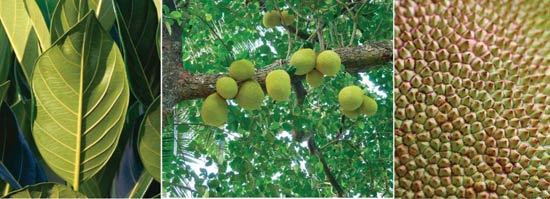The evergreen home garden tree
View(s):Artocarpus heterophyllus
- Common English name: Jak tree/Jakfruit tree
- Sinhala name: Kos/Herali;
Tamil name: Palapalam
- Family: Moraceae (The banyan family)
Its leaves are a dark, glossy green and oval-shaped, tapering to a point. The veins on the underside of the leaves are prominent. Flowers, barely recognisable as such, are borne in pale green bunches and these look like deflated balloons. Male and female flowers are found in separate bunches.

This tree can be identified readily by its very large, prickly, green ‘fruits’, borne close to the trunk. Pix by Gehan de Silva Wijeyeratne, Sriyanie Miththapala and Luxshmanan Nadaraja

In this series to mark Ruk Rakaganno’s 50th anniversary this year, Dr. Sriyanie Miththapala looks at some common trees
Composite fruits form from the green bunches of female flowers, and each may often weigh more than three kilogrammes. The green skin of these composite fruits has honeycomb-shaped markings, each of which represents a single flower. Each of these sections is raised like a tiny cone with a pointed tip, giving an overall appearance of a prickly fruit. In the composite fruit, there is a fleshy stem in the middle (the stem of the bunch of flowers), on which are borne many small, yellow fruits, each with a large seed and a fleshy, pale yellow pulp. This pulp darkens when ripe and emits a strong odour.
Unripe fruits are called polos in Sinhala and cooked as mallung or a much relished curry. The flesh of the ripe fruit is also eaten and may be firm (Sinhala: waraka) or soft and slightly slimy (Sinhala: wela). (There is no distinction made in Tamil.) The seeds are also cooked and eaten. In urban areas, ecologically, jak is important source of food for fruit-eating animals. The leaves are used as fodder for elephants in captivity.
Leaves, sap, fruits and roots are used in traditional medicine. The yellow wood is a valued timber. However, even on private land, it is against the law to cut a jak tree, without a permit. The timber also yields a yellow dye, which is used to dye the robes of Buddhist monks.
These trees were originally native to southwest India but are now cultivated widely in most tropical countries.
Extracted from ‘What tree is that?
The Ruk Rakaganno Layperson’s Guide to Some Trees of Sri Lanka’. Updated by the author using ‘Grown in Sri Lanka: cultivated flowering plants’ by Sriyanie Miththapala, Janaki Galappatti, and Siril Wijesundara (2015). The National Trust: Colombo.
Searching for an ideal partner? Find your soul mate on Hitad.lk, Sri Lanka's favourite marriage proposals page. With Hitad.lk matrimonial advertisements you have access to thousands of ads from potential suitors who are looking for someone just like you.


